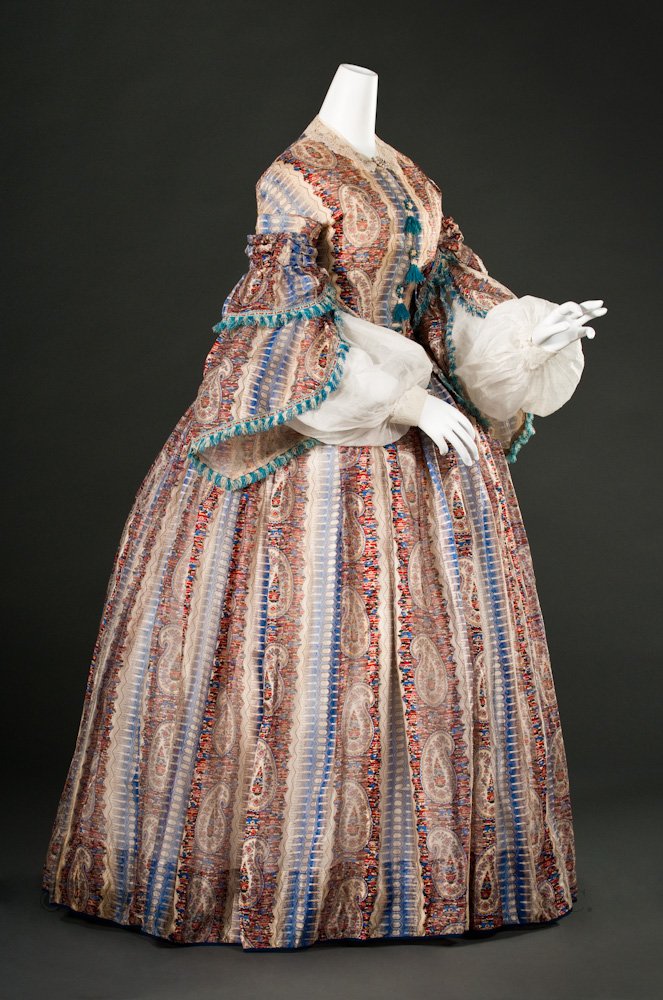Today's post is courtesy of our registrar, Meghan Grossman Hansen. In this post, Meghan examines the interaction between the fashionable silhouette and the human body in the second half of the nineteenth century. You'll also get a sneak peak at two day gowns featured in our upcoming exhibition, FABULOUS! Ten Years of FIDM Museum Acquisitions, 2000-2010.
As a fashion museum professional, I spend a lot of time looking at fashion plates. By examining these beautiful illustrations, including this one from the Los Angeles Public Library, the researcher becomes familiar with the fashionable silhouette in its most idealized state, an important part of learning about the history of fashion. And yet, on a daily basis, I work with clothes that were worn by actual women, not the idealized figures of fashion illustrations. This dichotomy of ideal and real comes to life when we dress a historic garment for exhibition.
 Day Gown
Day Gown
Paris, France, c. 1897
P. Barroin, Designer
Printed dotted Swiss, silk chiffon, silk taffeta & cotton braid
Gift of Jane Riggs & Lynelle Doll
2010.1098.3A-C
During a photography shoot for the forthcoming exhibition catalog, FABULOUS! Ten Years of FIDM Museum Acquisitions, 2000-2010, our curators selected this Parisian couture day dress by P. Barroin to represent the assimilation of sportswear into French high fashion. What we all noticed once she was dressed was her height, at least 5 feet 10 inches! We were all wowed by her height, and seeing this garment dressed was an object lesson in how changes to silhouette were proportional to the individual being dressed. For a woman of her height, the shoulder puffs and skirt hem were proportionately expanded. The result is a balanced shape of broad shoulders and wide skirts, accentuating the narrow waist. This Amazonian woman corseted herself down to 28 inches, a far cry from Scarlett O’Hara’s legendary 16 inch-waist. Nevertheless, this stately woman appears both fashionable and impressive in stature. This is incontrovertible proof against the myth that ‘everyone was smaller back then.’
 Day Gown
Day Gown
Europe or United States, c. 1857
Printed twill-striped silk gauze, silk fringe & silk ribbon
Museum Purchase
2009.5.47AB
Also featured in the FABULOUS! catalog, this c. 1857 day gown may seem to be at the same scale as our Gibson Girl above. In fact, the mannequin with her head would be just over 5 feet tall. Before dressing these two ensembles, the height difference is not immediately apparent. The 1897 red and white skirt is 42 inches long at center back, while the 1857 paisley skirt is 40.5 inches long at the same point. The bodice of the 5-foot tall woman is an inch longer than that of the 6-foot tall woman. How can this be?
There are two crucial elements that dictate how a historic garment will fit on a human body (or mannequin, as the case may be): waist and undergarments. Placement of the waist can range anywhere between just below the bust to hip level. At the time of the c. 1857 gown, crinolines were the latest fashion innovation, necessitating a truncated bodice and high waistline. The voluminous skirts of the late 1850s began their outward journey at the natural waistline or slightly above, while skirts of the 1890s began at or below the natural waist and tapered outward at the hem. Dresses of the late 1890s derived their grace from the sinuous lines of the Art Nouveau, in contrast to the late 1850s, during which fashion reached its fullest width in skirts and bell-shaped sleeves.
 Registrar Meghan Grossman Hansen with mannequin friend.
Registrar Meghan Grossman Hansen with mannequin friend.
Thus, the length of our 1850s skirt is truncated by a far-reaching hooped petticoat, while the 1890s skirt is left to extend to its full length. A combined understanding of the fashionable ideal from fashion plates, and the mundane reality of the human body, helps to bring the FIDM Museum historic fashion collection to life!


Thanks for such an informative post! I would love to see more like it in the future.